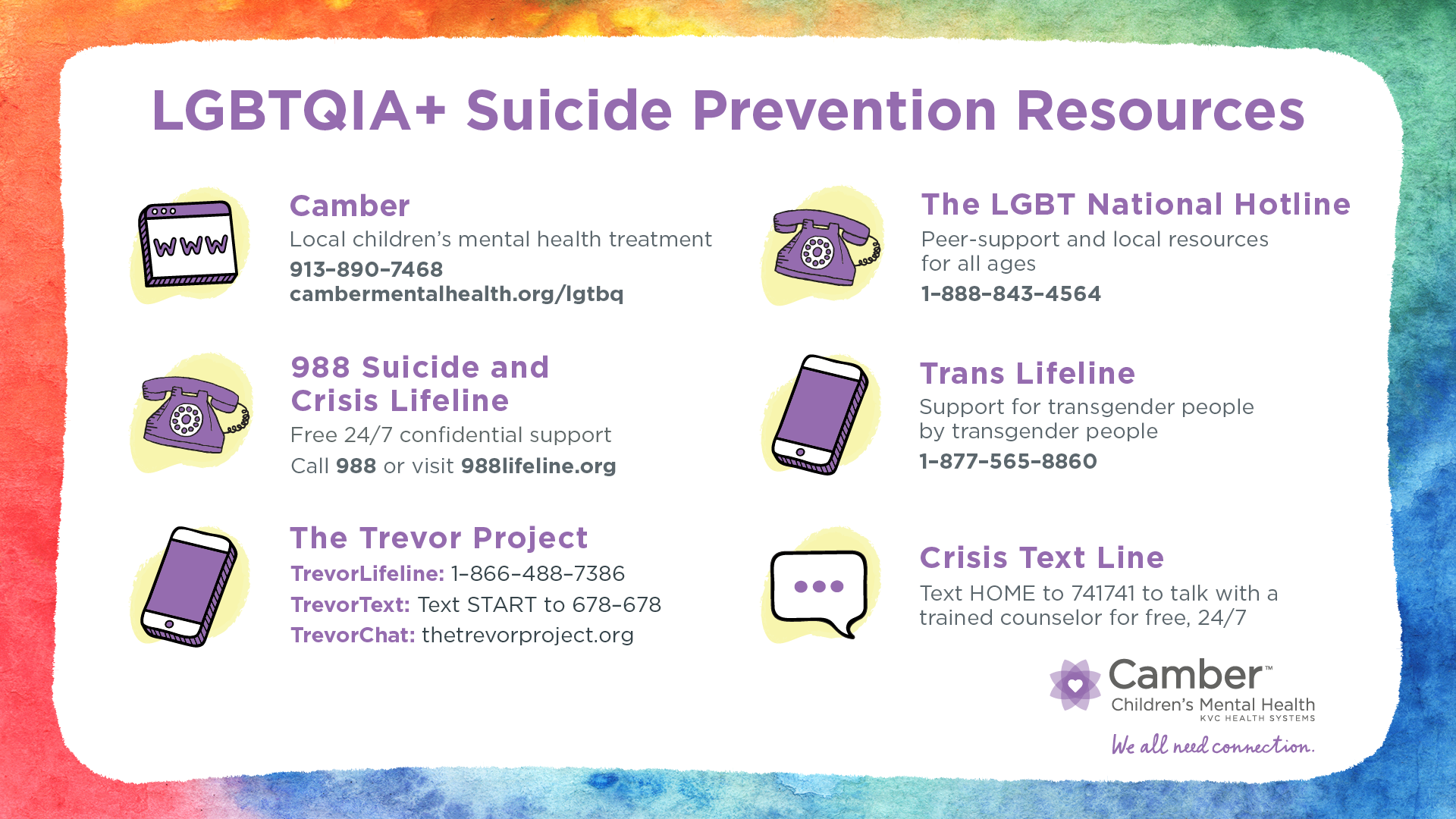- Locations
- How We Help
Overview
As the regional leader in youth mental health treatment, our innovative services help youth achieve health and wellness.
Treatment Programs
- Admissions
Overview
Learn how to admit your child to a Camber treatment location or make a client referral.
- Youth Disorders
- Resources
Overview
Our free resources help you stay informed and educated about mental health, brain development, and childhood trauma as well as how Camber is working toward building healthier communities.
- About Us
Overview
Our philosophy is to provide collaborative, compassionate and effective care through the use of timely, individualized treatment planning.
Learn More About Us
LGBTQIA+ Mental Health Resources
Every person deserves compassion, love, and to be accepted as who they truly are.
At Camber, we advocate for youth in the LGBTQIA+ community and give them a place where they can be heard, be themselves, and be connected to people who care. The heart of our work is giving support and compassion to every single child who comes through our doors. We are here to listen to their stories and help them heal from any trauma or pain they have experienced in life.
Throughout this page, we share resources to help people in the LGBTQIA+ community who are struggling with their mental health. Please join us in educating our communities by sharing these critical resources.
The words we use when talking about LGBTQIA+ individuals have a powerful impact on our conversations. The acronym LGBTQIA+ often stands for Lesbian; Gay; Bisexual; Transgender; Queer and/or Questioning; Intersex; and Asexual, Aromantic, and/or Agender.
![]()
Suicide is the second leading cause of death for youth ages 10 to 24. For LGBTQIA+ youth, that risk increases significantly as they are three times more likely than heterosexual youth to consider suicide.
Many LGBTQIA+ youth are rejected, neglected or abused by their families and communities who refuse to accept them for who they truly are. That rejection and trauma is heartbreaking for a child and has a detrimental impact on their brain development, mental health and long-term wellbeing. The Trevor Project’s 2021 National Survey shares that over the past year, two in three LGBTQ youth weren’t living in affirming homes. That means two out of three of these youth were living in a home that didn’t accept or support them.
Most LGBTQ+ youth experience discrimination and mistreatment based on their sexual orientation or gender identity and more than 80% are assaulted or threatened at some point in their life. These experiences are traumatic, damage a person’s feelings of self-worth, and amplify feelings of isolation and loneliness.
If you or someone you know in the LGBTQIA+ community are struggling with suicidal thoughts or other mental health challenges, keep reading for resources that can help.
Know the Warning Signs of Emotional Distress
If you’re concerned an LGBTQIA+ child or teen might be struggling with their mental health, here are some common signs and symptoms to watch out for:
- Drastic mood changes, such as increased anxiousness, sadness, irritability or anger
- Extreme mood changes
- Talking about feeling hopeless, wanting to die, or that there’s no point to life
- Excessive crying or irritation
- Fatigue or reduced energy
- Complaining of unexplained headaches, stomach aches or body pains
- Changes in sleeping habits (including sleeping too little or too much)
- Changes in eating habits (including eating too little or too much)
- Difficulties paying attention and concentrating (including forgetfulness and distraction)
- Withdrawing from family and/or friends
- Avoiding activities enjoyed in the past
- Returning to outgrown behaviors (for example, thumb-sucking or bedwetting)
- Self-harming or harming others
- Use of alcohol, tobacco or other drugs
- Poor school performance or avoiding schoolwork
How to Help a Child Who Is Struggling
You can take many preventative steps to help an LGBTQIA+ youth before they are in a mental health crisis. There isn’t a “one size fits all” when it comes to mental health and every child’s needs are different. Here are some examples of ways you can help:
- Tell them that they matter. Positive reinforcement is important.
- Have judgment-free conversations. Give them a safe person to speak openly to about their emotions or any struggles they’re facing.
- Get a professional assessment from their physician or a mental health professional. You can also download this free mental health assessment. This should not replace an exam by a medical professional but it can be a helpful place to start and it’s something you can do together at home.
- Encourage counseling. You don’t have to be in crisis to seek help. According to The Trevor Project, most LGBTQ youth report that they would like to receive counseling services but many of them don’t due to barriers to access. Help them get access to services.
- Reduce the risk of suicide by 50% by supporting a transgender or gender non-conforming youth’s chosen name and pronouns.
- Create affirming, inclusive spaces for LGBTQIA+ youth. Give them a safe place where they can be heard and help them build supportive connections & loving relationships in their communities.







